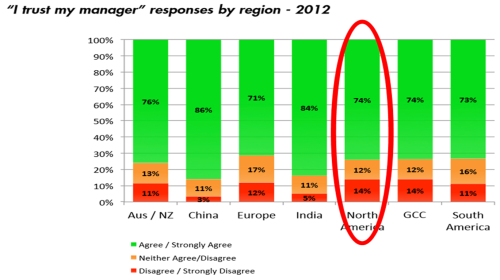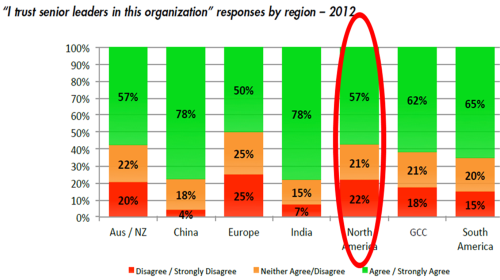BlessingWhite’s Employee Engagement Research Update has recently been released. It’s an update to their massive research published in 2011.
Measuring engagement is tricky – from gaining consensus on terms and definitions, to crafting survey questions that generate useful answers, to identifying key findings, to agreeing on recommendations – it’s all very tricky.
Global consulting firm BlessingWhite does a good job managing the trickiness. But truthfully, there’s not a lot of difference in engagement scores globally since their 2011 findings.
More trust of managers than executives
Here’s what caught my attention, though, as it did two years ago when I read through the report: a greater percentage of the workforce trust their managers more than they trust the executives in their organizations.
This makes sense, right? Managers have day-to-day interaction with their colleagues and can get to know them in personal ways. Executives, on the other hand, rarely have one-to-one interaction with the majority of the employees their organization. And the survey results show the difference in trust levels.

 It’s a good thing that employees in North America trust their managers more than they trust their senior leaders because there’s a high correlation between engagement and trust in managers. Or maybe it’s the other way around.
It’s a good thing that employees in North America trust their managers more than they trust their senior leaders because there’s a high correlation between engagement and trust in managers. Or maybe it’s the other way around.
Either way, BlessingWhite points out that while engaged employees have other factors that motivate them – like interesting work, a sense of contribution and career aspirations – less-engaged employees are far more dependent on knowing their manager personally to reach higher levels of engagement.
The tip of the engagement spear
This makes managers the tip of the engagement spear. And why we spend so much time focused on managerial effectiveness in almost every category of performance.
Not so with senior leaders, which is understandable because they don’t have the ability to interact personally with every employee, as BlessingWhite points out.
But they do have the responsibility to set the direction of the culture, communicate that direction with a “clear line-of-sight” throughout the organization, and create a culture that fuels engagement and business results.
In other words, set the managers up for success in engaging their teams in more personal ways.
4 key workforce needs
The CASE model, reviewed briefly at the end of the report, focuses senior leaders to fulfill four key workforce needs in building and leading their cultures:
- Community for a sense of belonging and purpose.
- Authenticity as a basis for trust and inspiration.
- Significance to recognize individuals’ contributions.
- Excitement to constantly encourage – and raise the bar on – high performance.
Managers can lead the way
It’s a good message for executives. It’s a great message for managers. And, it’s a call-to-action message for HR to know how to help executives drive performance and grow their culture while supporting managers to make more personal connections.
Engagement isn’t the answer to every organizational challenge. But it does seem clear that highly engaged workplaces are more productive than less engaged workforces.
And almost every organizational challenge I can think of gets solved more effectively and faster with an engaged workforce working the solution and being led by managers who are personally leading the way.
This originally appeared on China Gorman’s blog at ChinaGorman.com.
